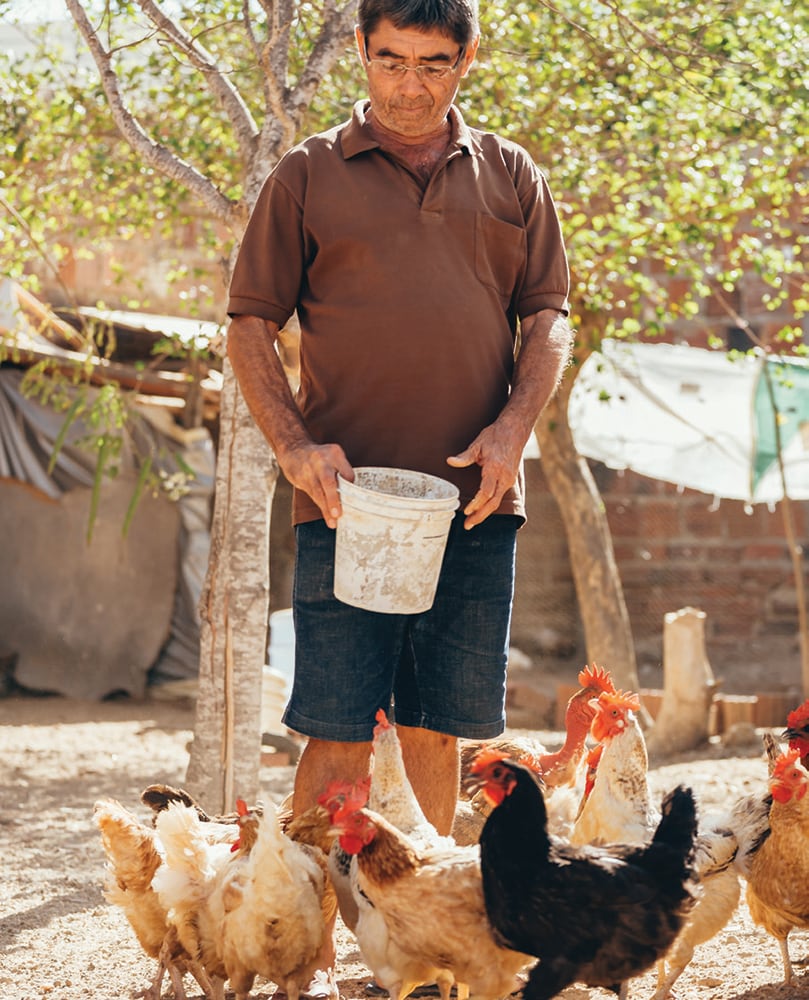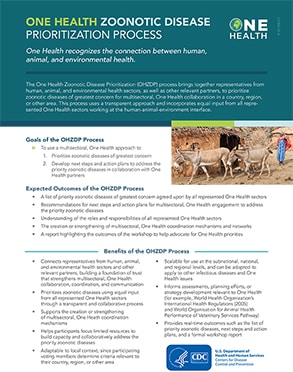One Health Zoonotic Disease Prioritization Process Overview
One Health recognizes the connection between human, animal, and environmental health.
The One Health Zoonotic Disease Prioritization (OHZDP) process brings together representatives from human, animal, and environmental health sectors, as well as other relevant partners, to prioritize zoonotic diseases of greatest concern for multisectoral, One Health collaboration in a country, region, or other area. This process uses a transparent approach and incorporates equal input from all represented One Health sectors working at the human-animal-environment interface.
Goals of the OHZDP Process
To use a multisectoral, One Health approach to
- Prioritize zoonotic diseases of greatest concern
- Develop next steps and action plans to address the priority zoonotic diseases in collaboration with One Health partners
Expected Outcomes of the OHZDP Process
- A list of priority zoonotic diseases of greatest concern agreed upon by all represented One Health sectors
- Recommendations for next steps and action plans for multisectoral, One Health engagement to address the priority zoonotic diseases
- Understanding of the roles and responsibilities of all represented One Health sectors
- The creation or strengthening of multisectoral, One Health coordination mechanisms and networks
- A report highlighting the outcomes of the workshop to help advocate for One Health priorities

Benefits of the OHZDP Process
- Connects representatives from human, animal, and environmental health sectors and other relevant partners, building a foundation of trust that strengthens multisectoral, One Health collaboration, coordination, and communication
- Prioritizes zoonotic diseases using equal input from all represented One Health sectors through a transparent and collaborative process
- Supports the creation or strengthening of multisectoral, One Heath coordination mechanisms
- Helps participants focus limited resources to build capacity and collaboratively address the priority zoonotic diseases
- Adaptable to local context, since participating voting members determine criteria relevant to their country, region, or other area
- Scalable for use at the subnational, national, and regional levels, and can be adapted to apply to other infectious diseases and One Health issues
- Informs assessments, planning efforts, or strategy development relevant to One Health (for example, World Health Organization’s International Health Regulations [2005] and World Organisation for Animal Health Performance of Veterinary Services Pathway)
- Provides real-time outcomes such as the list of priority zoonotic diseases, next steps and action plans, and a formal workshop report

No one person, organization, or sector can effectively address health threats at the human-animal-environment interface. alone
Participants of the OHZDP Process
FACILITATORS: Typically 3-6 facilitators
- Representatives from human, animal, and environmental health sectors serve as neutral, trained facilitators for the workshop.
VOTING MEMBERS: Up to 12 voting members
- Equal representation of government staff from One Health sectors actively involved in zoonotic disease prevention and control.
- Human health/public health
- Agriculture/livestock
- Wildlife (fisheries)
- Environment (forestry, land management)
- Other government sectors active in zoonotic disease workVoting members could represent the following sectors:
ADVISORS: Typically 10 -15 advisors
- Key partners and stakeholders who provide advice and expertise to voting members and support post-workshop collaborative activities.
- Advisors can represent the following organizations that are involved in zoonotic disease work:
- Other government sectors not directly involved in zoonotic disease work (for example, finance, education, or tourism)
- International organizations (for example, CDC, WHO, FAO, WOAH, USAID)
- Key academic partners or university networks
- Non-governmental institutions
Preparing for the OHZDP Process
- CDC’s One Health Office is available to train facilitators to design a workshop to meet specific needs of a country, region, or other area.
- A minimum of 3 months is needed to prepare for a single OHZDP Workshop. More preparation time is recommended for larger workshops, such as a regional workshop.
- Preparation includes acquiring resources, identifying appropriate workshop participants, conducting a literature review for an initial list of zoonotic diseases for prioritization, and finalizing workshop logistics.
- At least three trained, neutral facilitators from different sectors are needed to assist the local team with workshop preparation and facilitation (for example, one facilitator each from Ministry of Health, Ministry of Agriculture, Ministry of Wildlife, and Ministry of Environment).

Before the Workshop
Prepare and Plan for the Workshop
- Contact the CDC One Health Office at least 3 months before scheduling a workshop.
- Identify Core Planning Team and obtain financial resources to accommodate for workshop logistics, venue, materials, travel, and translation
- Identify workshop participants (facilitators, voting members, advisors) from human, animal, and environmental health sectors and other related partners.
- Generate an initial list of zoonotic diseases to be considered for prioritization using reportable disease lists, literature, and input from all represented One Health sectors.
- Conduct a literature review on the initial list of zoonotic diseases by reviewing publications, reports, grey literature, etc.
During the Workshop
Develop Criteria
- 5 criteria will be used to prioritize the list of zoonotic diseases; criteria are locally appropriate and address the needs of each unique location.
Develop Questions
- 1 categorical question will be developed to measure each criteria.
Rank Criteria
- Each voting member will rank criteria in their preferred order, allowing each sector to address their sector’s priorities and needs. Individual rankings are combined to produce a combined ranked list of criteria.
Prioritize Zoonotic Diseases
- Score each zoonotic disease by answering the categorical questions for each weighted criterion and entering this data into the OHZDP Tool.
- The ranked zoonotic disease list from the OHZDP Tool is used to facilitate discussion among the participants to finalize the priority zoonotic disease list.
Discuss Next Steps and Action Plans for Multisectoral, One Health Engagement
- Discuss next steps and action plans for identifying areas for One Health engagement for prevention and control of the prioritized zoonotic diseases.
After the Workshop
- Stakeholders advocate and implement recommended next steps and action plans to implement a One Health approach for the priority zoonotic diseases.


